Dec 02, 2009 (LBO) - 2009 has been year of celebration for the ICT Agency, the entity created to implement the e Sri Lanka program. The capping event is the big regional conference that has come to town, giving ICTA dignitaries an opportunity to strut their stuff on a larger stage.
The declaration of 2009 as the Year of IT and English signified Presidential blessing. Earlier this year, officials from Dhaka came calling, seeking lessons for Digital Bangladesh. The e swabhimani awards were launched. The 1919 government information center was recognized to the gratification of the World Bank. For the first Sri Lankan government agency that was supposed to go out of business after having completed its work (by 2008), the first full year of non-sunsetted existence has been full of pomp and ceremony.
What did it achieve in its originally allotted five years? It would be useful to identify criteria that may be used by the citizens of Sri Lanka to assess success and hold it accountable for the next five years.
Success criteria must be related to outputs, not inputs. Not money spent but results achieved in forms that citizens and stakeholders can perceive. The measures would, ideally, be comparative (also applied to other countries). Sri Lanka must have improved its standing relative to our peers. Equipped as it was with a large World Bank credit and empowered as part of the President’s Office, ICTA has no excuses if success has not been achieved.
Assessing success: Exports
The tagline “smart island, smart people,” adopted in 2002 and retained by the new owners, indicated a wish to make Sri Lanka a more knowledge-based economy. Last year’s export value study commissioned by the Export Development Board (note: an entity other than ICTA) suggests that considerable progress has indeed been made.
In 2002, when e Sri Lanka planning started, the country had negligible activity in the IT enabled services sector. Today, the combined IT and IT enabled services sector is the fifth highest export earner (USD 213 million in 2007), and the second most important service-export industry, behind tourism (USD 410 m in 2007). The main driver of the sector is software, which constitutes two thirds of the total value (USD 154 m in 2007).
One may argue that the momentum in the software industry preceded e Sri Lanka. After all, Virtusa and Millennium IT predated e Sri Lanka. And while the lifespan of the Lanka Software Foundation overlaps with that of ICTA, it got minimal support from ICTA in placing Sri Lanka as a major player in the middleware and disaster-management software spaces. This debate can only be settled by a systematic examination of the respective contributions made by ICTA and by other factors to the progress of the software export industry.
Sri Lanka is now a rising player in the worldwide BPO industry. This is undoubtedly related to e Sri Lanka and the incomplete liberalization of the international gateways in telecom in 2003, giving the BPO firms a choice among suppliers and media. ICTA was not solely responsible for attracting the HSBC’s group service center to the prominent location on Parliament Road, to serve as a short answer to the question “can you do BPO business in Sri Lanka?” but it surely was a major contributor.
Despite the war and the resultant bad press and the lack of improvements in infrastructures, the BPO industry has grown, and grown in the right way. We have more or less avoided the entry-level call-center business and capitalized on Sri Lanka’s strength in accounting and other professions. Making cold calls to aggravated housewives in the West does not a smart island make. Only 15 percent of the IT enabled sector is voice only, with over 70 percent being data only and the rest being voice plus data.
The growth of the BPO industry has been felt by people. The day that I knew we had achieved something was when the parents of two young men who had asked me to find jobs for them told me very happily that they were employed in BPOs. These were English-speaking middle-class people, but the effect extends beyond those who directly work in BPOs. Just ask the owners and drivers of the vans that provide transport to and from the BPO locations. With inshoring, the opportunities extend beyond the middle class as evidenced by the young people working for John Keells from Mahavilachchiya.
ICTA has begun to address the key constraint of skilled workers, especially outside Colombo. More can be done in addressing the infrastructure constraints of energy and public transportation, but clearly the growth of the IT enabled industry is something ICTA can take satisfaction in. The rise in the AT Kearney BPO rankings from 29th in 2007 to 16th in 2009 shows real progress. Additional investments in the BPO sector depend on perception. Rankings are clearly important in reflecting and influencing perception.
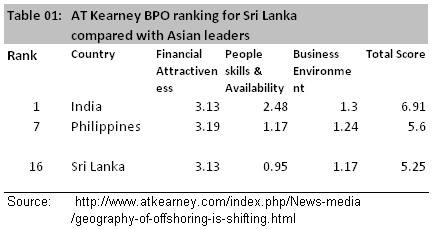 Assessing success: e gov
Assessing success: e gov
e government was central to the design of e Sri Lanka. The hope was that many things would flow from the delivery of government services to all citizens (and those in the Diaspora) irrespective of where they lived. First and foremost, it would help reengineer government business processes, increasing efficiency and offering new services and functionalities. At the same time, satisfying the preconditions for countrywide delivery of e government services would necessarily satisfy the preconditions for e commerce, except perhaps the logistics/delivery element. It would, for example, help us develop a Public Key Infrastructure as a key element in ensuring trust in electronic transactions across distance and also e payment mechanisms other than credit cards, both essential for a full-fledged e gov system, and both key preconditions for domestic, large-scale e commerce.
Another indicator of the importance given to e gov at the outset was the recruitment of Lalith Weeratunge, one of Sri Lanka’s most eminent government servants, as the Director responsible for e government, a position he occupied until he was appointed as Secretary to the Prime Minister in 2004 after the election. Appointing CIOs in government organizations was his idea. CIO was not an acronym for Chief Information Officer; it stood for Chief Innovation Officer.
There are clear success stories. The Department of Immigration and Emigration is a bright shining light, issuing more passports in one day than the Department of Registration of Persons issues National Identity Cards. 1919 has been justly given recognition. Where but at 1919 can a citizen obtain government services in all three official languages from courteous people? But 1919 continues to be a rudimentary e government service, limited to providing information and not adding features that would allow more functions to be completed on the phone itself.
The big picture is not too good, particularly for the country that poured millions into e gov. Sri Lanka has slipped in the UN e government rankings from 94th place in 2005 to 101st place in 2008. The only consolation is that we have dropped less than India, resulting in us being ahead of our big neighbor in 2008. And the gap that we need to close to become the leader of the low-performing SAARC countries is now only 6.
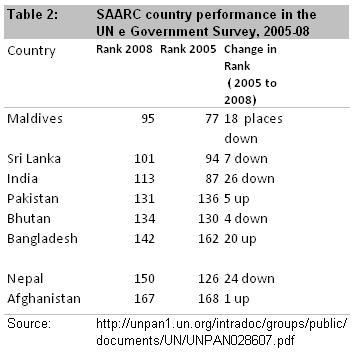
Five years of work has made no discernible impact on improving the overall efficiency of government services. The approximately 3,000 calls received a day by 1919 is miniscule in relation to the calls received by the 311 service in New York City which receives 50,000 calls a day on average when you consider that 1919 is serving 20 million people, and New York City government possibly less. e gov is not as great a success story as we would wish. A systematic examination of what went right and what went wrong, by an independent entity, is clearly called for.
Assessing success: e society
Here, the focus was on a challenge fund that would encourage decentralized innovation. Grants have been given and many pilot projects implemented. The real test, of course, is what has been scaled up on a sustainable basis. I cannot think of anything off the top of my head. But I am sure there are a few. This needs to be documented.
Assessing success: Electronic connectivity
The two key elements were the building out of regional telecom networks (RTNs) using smart subsidies and the establishment of common-access points (telecenters). Much money has been spent on the latter while the former was still born.
Two RTNs were planned in 2003, one for the Deep South, a fiber optic ring with Hambantota as the furthest point, and one for the North East, a fiber cable that would connect Anuradhapura and Trincomalee to the fiber ring that at that point went only up to Kurunegala and Matale.
Many things stymied the RTNs: frictions between the Telecom Regulatory Commission and ICTA, court cases launched by the existing telecom operators unhappy that the attendant telecom reforms that had been promised the breakdown of the ceasefire, etc. The friction was removed by the President taking over the TRC and making his Secretary the Chairman and his associate the Director General. But still, the RTNs did not materialize.
But all the places that the RTNs intended to connect with fiber are today so connected. Getting the intended result without spending public funds could be chalked up as a success. All that remains is to ensure that all operators can use the fiber that has been laid on a cost-oriented and non-discriminatory basis. This is something that only the Telecom Regulatory Commission can do, so ICTA is shielded from blame.
There are many, many telecenters. Contrary to the original plan that would have limited them to rural and underserved areas, they can be found in the middle of cities like Kandy and Anuradhapura. The original plan was to transparently select people who had experience in running businesses and whose applications included viable business plans. This was abandoned after the first round when the government changed, with beneficiaries being decided on by the Presidential Secretariat, among them a significant number of Buddhist temples. The end result was the proliferation of unsustainable telecenters that are already going bust, as shown by the photographs above.
But more people than ever are connected to the Internet today, not through government subsidized telecenters, but through the competition-driven proliferation of fixed and mobile broadband, enabled, of course, by the issuance of the required frequencies by the TRC. One wishes that this result could have been achieved with less waste of government and private resources, but again, one may arguably claim that e Sri Lanka contributed to increasing awareness of, and demand for, the Internet in Sri Lanka.
Assessing success: Computer literacy
This was not a formal component of e Sri Lanka, but one that has been claimed as a success by the President. Contrary to his February 2008 claim of 25 percent computer literacy achieved through ICTA’s work, the Department of Census and Statistics states that computer literacy was 16.1 percent in 2006-07, up from 9.7 percent in 2004. This is significant, though not exceptional, increase. Unfortunately, comparative figures using the same definition are not available.
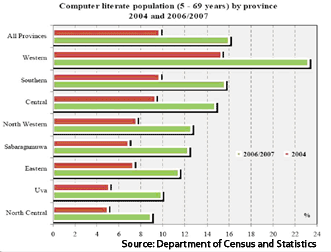 Assessing success: Overall
Assessing success: Overall
Sri Lanka has come a long way in the use of ICTs, but we have a long way to go. My guess is that we would not be where we are today if not for e Sri Lanka. A full assessment is needed to see if we have come as far as we could have come.
Sri Lanka has risen nine places in the World Economic Forum’s Network Readiness Index (70th place in relation to the countries assessed in 2007; was 79th in 2007-08). Among its SAARC peers, it is behind India by 18 places. The NRI does not rank the other smaller SAARC countries.
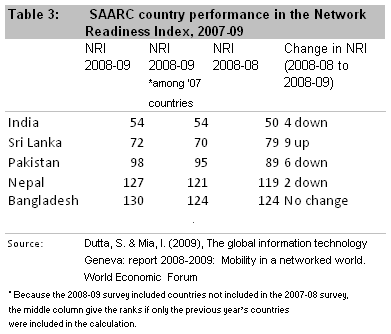
Sri Lanka has done well in the NRI since its inclusion in 2001-02. Starting from the 9th decile, it rose to the 6th decile by 2008-09, which suggests that there has been a distinct improvement in perception since e Sri Lanka began. The NRI uses soft data such as perceptions of influential actors from surveys (60 percent) as well as hard data, obtained from multiple sources including governments (40 percent) and has lower coverage (only 5 of the 8 SAARC countries are included). By contrast, the ITU’s ICT Development Index (IDI) uses hard data only and covers a larger number of countries; within South Asia, the only country excluded is Afghanistan. The NRI covers 2008-09 and is current. The ITU assesses the 2002-2007 period, more or less corresponding to ICTA’s life (2003-2008).
Sri Lanka has slipped three places in the ITU’s ICT Development Index (IDI) (97 in 2002 to 100 in 2007). We have been displaced three places by Azerbaijan (which advanced 14 places from 100 in 2002), Vietnam (which went from 107 to 92) and Algeria (which jumped from 105 to 97). Among our SAARC peers, we still hold second place but Maldives’s lead has increased from 9 places in 2002 to 29 in 2007. Bhutan was behind by 21 places in 2002; now it is behind by only 15. The gap Pakistan had to cover to equal Sri Lanka in 2002 was 49. It has shrunk to 27 by 2007.
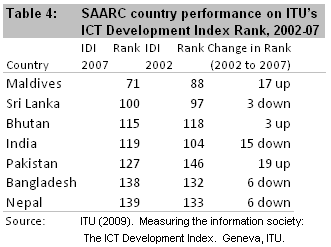
The ITU Index gives most weight to access (40 percent) and use (40 percent), where Sri Lanka has made progress, but not enough compared to others. Sri Lanka moves five places in access, while the Maldives moves 13 and Pakistan 17. This is a race where one has to run hard just to stay in place.
Sri Lanka has dropped 6 places on the lower-weighted skills component (20 percent of the overall weight). This component is based on educational enrolment as a proxy for ICT literacy (not specifically ICTs). Here, Sri Lanka has a historical advantage, and is thus still ahead of its SAARC peers. Interestingly, there is little ICTA can do about improving performance under this component.
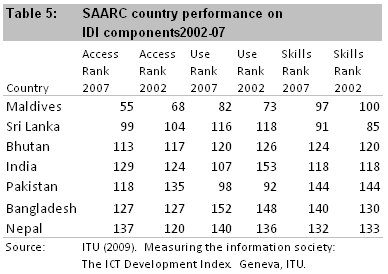
To advance in the overall rankings, it is not enough to move one or two places in the access or use sub-index rankings. An effective implementation agency will make a concerted effort to increase performance across several heavily-weighted subcomponents such as “mobile broadband connections per 100 inhabitants” (15.3 percent of the total) and “Internet users per 100 inhabitants” (12.8 percent). It is possible that the lethargic and obsolete data collection and reporting practices of the TRC may be leading to low or incorrect numbers being reported to the ITU and thus bringing down Sri Lanka’s performance. Good implementation would include exerting pressure on the TRC’s indicators unit to adopt modern data reporting practices.
Comparing the performances of Vietnam (which advanced 15 places to overtake Sri Lanka) and Sri Lanka (which dropped three places) on the heaviest weighted subcomponents that ICTA and the TRC are capable of influencing is illuminating. Vietnam increased Internet users/100 more than tenfold, while Sri Lanka increased only fourfold. Even when starting from nothing, Vietnam did better: Fixed broadband increased to 1.5 per 100, while Sri Lanka went from nothing to only 0.3 (or 1.1 if mobile broadband is also included).
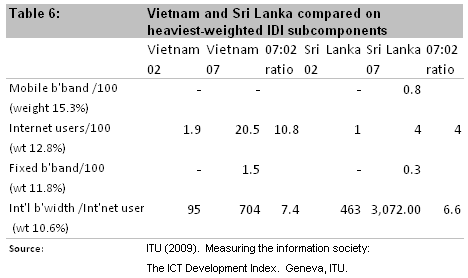
Vietnam’s prowess is also confirmed by the World Economic Forum: included in the NRI surveys since 2001-02 along with Sri Lanka, it has advanced from the 10th decile to the 6th decile of the countries studied, exceeding Sri Lanka’s progress.
Sri Lanka has progressed, but not enough to improve, or even maintain, our standing relative to other countries. Equipped as we were with a large World Bank (International Development Association) credit and an exemplary implementing organization under the President’s Office, we should have been sprinting. Instead, we had been ambling.
"Ideas actioned" is ICTA’s tagline. If the results are not good enough, something must be wrong with the ideas, the actions, or the actors. It is worth finding out which.
Rohan Samarajiva heads LirneAsia, a regional think tank. He was also a former telecoms regulator in Sri Lanka. To read previous columns go to the main navigation panel and click on 'Choices' category.  Assessing success: e gov
e government was central to the design of e Sri Lanka. The hope was that many things would flow from the delivery of government services to all citizens (and those in the Diaspora) irrespective of where they lived. First and foremost, it would help reengineer government business processes, increasing efficiency and offering new services and functionalities. At the same time, satisfying the preconditions for countrywide delivery of e government services would necessarily satisfy the preconditions for e commerce, except perhaps the logistics/delivery element. It would, for example, help us develop a Public Key Infrastructure as a key element in ensuring trust in electronic transactions across distance and also e payment mechanisms other than credit cards, both essential for a full-fledged e gov system, and both key preconditions for domestic, large-scale e commerce.
Another indicator of the importance given to e gov at the outset was the recruitment of Lalith Weeratunge, one of Sri Lanka’s most eminent government servants, as the Director responsible for e government, a position he occupied until he was appointed as Secretary to the Prime Minister in 2004 after the election. Appointing CIOs in government organizations was his idea. CIO was not an acronym for Chief Information Officer; it stood for Chief Innovation Officer.
There are clear success stories. The Department of Immigration and Emigration is a bright shining light, issuing more passports in one day than the Department of Registration of Persons issues National Identity Cards. 1919 has been justly given recognition. Where but at 1919 can a citizen obtain government services in all three official languages from courteous people? But 1919 continues to be a rudimentary e government service, limited to providing information and not adding features that would allow more functions to be completed on the phone itself.
The big picture is not too good, particularly for the country that poured millions into e gov. Sri Lanka has slipped in the UN e government rankings from 94th place in 2005 to 101st place in 2008. The only consolation is that we have dropped less than India, resulting in us being ahead of our big neighbor in 2008. And the gap that we need to close to become the leader of the low-performing SAARC countries is now only 6.
Assessing success: e gov
e government was central to the design of e Sri Lanka. The hope was that many things would flow from the delivery of government services to all citizens (and those in the Diaspora) irrespective of where they lived. First and foremost, it would help reengineer government business processes, increasing efficiency and offering new services and functionalities. At the same time, satisfying the preconditions for countrywide delivery of e government services would necessarily satisfy the preconditions for e commerce, except perhaps the logistics/delivery element. It would, for example, help us develop a Public Key Infrastructure as a key element in ensuring trust in electronic transactions across distance and also e payment mechanisms other than credit cards, both essential for a full-fledged e gov system, and both key preconditions for domestic, large-scale e commerce.
Another indicator of the importance given to e gov at the outset was the recruitment of Lalith Weeratunge, one of Sri Lanka’s most eminent government servants, as the Director responsible for e government, a position he occupied until he was appointed as Secretary to the Prime Minister in 2004 after the election. Appointing CIOs in government organizations was his idea. CIO was not an acronym for Chief Information Officer; it stood for Chief Innovation Officer.
There are clear success stories. The Department of Immigration and Emigration is a bright shining light, issuing more passports in one day than the Department of Registration of Persons issues National Identity Cards. 1919 has been justly given recognition. Where but at 1919 can a citizen obtain government services in all three official languages from courteous people? But 1919 continues to be a rudimentary e government service, limited to providing information and not adding features that would allow more functions to be completed on the phone itself.
The big picture is not too good, particularly for the country that poured millions into e gov. Sri Lanka has slipped in the UN e government rankings from 94th place in 2005 to 101st place in 2008. The only consolation is that we have dropped less than India, resulting in us being ahead of our big neighbor in 2008. And the gap that we need to close to become the leader of the low-performing SAARC countries is now only 6.
 Five years of work has made no discernible impact on improving the overall efficiency of government services. The approximately 3,000 calls received a day by 1919 is miniscule in relation to the calls received by the 311 service in New York City which receives 50,000 calls a day on average when you consider that 1919 is serving 20 million people, and New York City government possibly less. e gov is not as great a success story as we would wish. A systematic examination of what went right and what went wrong, by an independent entity, is clearly called for.
Assessing success: e society
Here, the focus was on a challenge fund that would encourage decentralized innovation. Grants have been given and many pilot projects implemented. The real test, of course, is what has been scaled up on a sustainable basis. I cannot think of anything off the top of my head. But I am sure there are a few. This needs to be documented.
Assessing success: Electronic connectivity
The two key elements were the building out of regional telecom networks (RTNs) using smart subsidies and the establishment of common-access points (telecenters). Much money has been spent on the latter while the former was still born.
Two RTNs were planned in 2003, one for the Deep South, a fiber optic ring with Hambantota as the furthest point, and one for the North East, a fiber cable that would connect Anuradhapura and Trincomalee to the fiber ring that at that point went only up to Kurunegala and Matale.
Many things stymied the RTNs: frictions between the Telecom Regulatory Commission and ICTA, court cases launched by the existing telecom operators unhappy that the attendant telecom reforms that had been promised the breakdown of the ceasefire, etc. The friction was removed by the President taking over the TRC and making his Secretary the Chairman and his associate the Director General. But still, the RTNs did not materialize.
But all the places that the RTNs intended to connect with fiber are today so connected. Getting the intended result without spending public funds could be chalked up as a success. All that remains is to ensure that all operators can use the fiber that has been laid on a cost-oriented and non-discriminatory basis. This is something that only the Telecom Regulatory Commission can do, so ICTA is shielded from blame.
There are many, many telecenters. Contrary to the original plan that would have limited them to rural and underserved areas, they can be found in the middle of cities like Kandy and Anuradhapura. The original plan was to transparently select people who had experience in running businesses and whose applications included viable business plans. This was abandoned after the first round when the government changed, with beneficiaries being decided on by the Presidential Secretariat, among them a significant number of Buddhist temples. The end result was the proliferation of unsustainable telecenters that are already going bust, as shown by the photographs above.
But more people than ever are connected to the Internet today, not through government subsidized telecenters, but through the competition-driven proliferation of fixed and mobile broadband, enabled, of course, by the issuance of the required frequencies by the TRC. One wishes that this result could have been achieved with less waste of government and private resources, but again, one may arguably claim that e Sri Lanka contributed to increasing awareness of, and demand for, the Internet in Sri Lanka.
Assessing success: Computer literacy
This was not a formal component of e Sri Lanka, but one that has been claimed as a success by the President. Contrary to his February 2008 claim of 25 percent computer literacy achieved through ICTA’s work, the Department of Census and Statistics states that computer literacy was 16.1 percent in 2006-07, up from 9.7 percent in 2004. This is significant, though not exceptional, increase. Unfortunately, comparative figures using the same definition are not available.
Five years of work has made no discernible impact on improving the overall efficiency of government services. The approximately 3,000 calls received a day by 1919 is miniscule in relation to the calls received by the 311 service in New York City which receives 50,000 calls a day on average when you consider that 1919 is serving 20 million people, and New York City government possibly less. e gov is not as great a success story as we would wish. A systematic examination of what went right and what went wrong, by an independent entity, is clearly called for.
Assessing success: e society
Here, the focus was on a challenge fund that would encourage decentralized innovation. Grants have been given and many pilot projects implemented. The real test, of course, is what has been scaled up on a sustainable basis. I cannot think of anything off the top of my head. But I am sure there are a few. This needs to be documented.
Assessing success: Electronic connectivity
The two key elements were the building out of regional telecom networks (RTNs) using smart subsidies and the establishment of common-access points (telecenters). Much money has been spent on the latter while the former was still born.
Two RTNs were planned in 2003, one for the Deep South, a fiber optic ring with Hambantota as the furthest point, and one for the North East, a fiber cable that would connect Anuradhapura and Trincomalee to the fiber ring that at that point went only up to Kurunegala and Matale.
Many things stymied the RTNs: frictions between the Telecom Regulatory Commission and ICTA, court cases launched by the existing telecom operators unhappy that the attendant telecom reforms that had been promised the breakdown of the ceasefire, etc. The friction was removed by the President taking over the TRC and making his Secretary the Chairman and his associate the Director General. But still, the RTNs did not materialize.
But all the places that the RTNs intended to connect with fiber are today so connected. Getting the intended result without spending public funds could be chalked up as a success. All that remains is to ensure that all operators can use the fiber that has been laid on a cost-oriented and non-discriminatory basis. This is something that only the Telecom Regulatory Commission can do, so ICTA is shielded from blame.
There are many, many telecenters. Contrary to the original plan that would have limited them to rural and underserved areas, they can be found in the middle of cities like Kandy and Anuradhapura. The original plan was to transparently select people who had experience in running businesses and whose applications included viable business plans. This was abandoned after the first round when the government changed, with beneficiaries being decided on by the Presidential Secretariat, among them a significant number of Buddhist temples. The end result was the proliferation of unsustainable telecenters that are already going bust, as shown by the photographs above.
But more people than ever are connected to the Internet today, not through government subsidized telecenters, but through the competition-driven proliferation of fixed and mobile broadband, enabled, of course, by the issuance of the required frequencies by the TRC. One wishes that this result could have been achieved with less waste of government and private resources, but again, one may arguably claim that e Sri Lanka contributed to increasing awareness of, and demand for, the Internet in Sri Lanka.
Assessing success: Computer literacy
This was not a formal component of e Sri Lanka, but one that has been claimed as a success by the President. Contrary to his February 2008 claim of 25 percent computer literacy achieved through ICTA’s work, the Department of Census and Statistics states that computer literacy was 16.1 percent in 2006-07, up from 9.7 percent in 2004. This is significant, though not exceptional, increase. Unfortunately, comparative figures using the same definition are not available.
 Assessing success: Overall
Sri Lanka has come a long way in the use of ICTs, but we have a long way to go. My guess is that we would not be where we are today if not for e Sri Lanka. A full assessment is needed to see if we have come as far as we could have come.
Sri Lanka has risen nine places in the World Economic Forum’s Network Readiness Index (70th place in relation to the countries assessed in 2007; was 79th in 2007-08). Among its SAARC peers, it is behind India by 18 places. The NRI does not rank the other smaller SAARC countries.
Assessing success: Overall
Sri Lanka has come a long way in the use of ICTs, but we have a long way to go. My guess is that we would not be where we are today if not for e Sri Lanka. A full assessment is needed to see if we have come as far as we could have come.
Sri Lanka has risen nine places in the World Economic Forum’s Network Readiness Index (70th place in relation to the countries assessed in 2007; was 79th in 2007-08). Among its SAARC peers, it is behind India by 18 places. The NRI does not rank the other smaller SAARC countries.
 Sri Lanka has done well in the NRI since its inclusion in 2001-02. Starting from the 9th decile, it rose to the 6th decile by 2008-09, which suggests that there has been a distinct improvement in perception since e Sri Lanka began. The NRI uses soft data such as perceptions of influential actors from surveys (60 percent) as well as hard data, obtained from multiple sources including governments (40 percent) and has lower coverage (only 5 of the 8 SAARC countries are included). By contrast, the ITU’s ICT Development Index (IDI) uses hard data only and covers a larger number of countries; within South Asia, the only country excluded is Afghanistan. The NRI covers 2008-09 and is current. The ITU assesses the 2002-2007 period, more or less corresponding to ICTA’s life (2003-2008).
Sri Lanka has slipped three places in the ITU’s ICT Development Index (IDI) (97 in 2002 to 100 in 2007). We have been displaced three places by Azerbaijan (which advanced 14 places from 100 in 2002), Vietnam (which went from 107 to 92) and Algeria (which jumped from 105 to 97). Among our SAARC peers, we still hold second place but Maldives’s lead has increased from 9 places in 2002 to 29 in 2007. Bhutan was behind by 21 places in 2002; now it is behind by only 15. The gap Pakistan had to cover to equal Sri Lanka in 2002 was 49. It has shrunk to 27 by 2007.
Sri Lanka has done well in the NRI since its inclusion in 2001-02. Starting from the 9th decile, it rose to the 6th decile by 2008-09, which suggests that there has been a distinct improvement in perception since e Sri Lanka began. The NRI uses soft data such as perceptions of influential actors from surveys (60 percent) as well as hard data, obtained from multiple sources including governments (40 percent) and has lower coverage (only 5 of the 8 SAARC countries are included). By contrast, the ITU’s ICT Development Index (IDI) uses hard data only and covers a larger number of countries; within South Asia, the only country excluded is Afghanistan. The NRI covers 2008-09 and is current. The ITU assesses the 2002-2007 period, more or less corresponding to ICTA’s life (2003-2008).
Sri Lanka has slipped three places in the ITU’s ICT Development Index (IDI) (97 in 2002 to 100 in 2007). We have been displaced three places by Azerbaijan (which advanced 14 places from 100 in 2002), Vietnam (which went from 107 to 92) and Algeria (which jumped from 105 to 97). Among our SAARC peers, we still hold second place but Maldives’s lead has increased from 9 places in 2002 to 29 in 2007. Bhutan was behind by 21 places in 2002; now it is behind by only 15. The gap Pakistan had to cover to equal Sri Lanka in 2002 was 49. It has shrunk to 27 by 2007.
 The ITU Index gives most weight to access (40 percent) and use (40 percent), where Sri Lanka has made progress, but not enough compared to others. Sri Lanka moves five places in access, while the Maldives moves 13 and Pakistan 17. This is a race where one has to run hard just to stay in place.
Sri Lanka has dropped 6 places on the lower-weighted skills component (20 percent of the overall weight). This component is based on educational enrolment as a proxy for ICT literacy (not specifically ICTs). Here, Sri Lanka has a historical advantage, and is thus still ahead of its SAARC peers. Interestingly, there is little ICTA can do about improving performance under this component.
The ITU Index gives most weight to access (40 percent) and use (40 percent), where Sri Lanka has made progress, but not enough compared to others. Sri Lanka moves five places in access, while the Maldives moves 13 and Pakistan 17. This is a race where one has to run hard just to stay in place.
Sri Lanka has dropped 6 places on the lower-weighted skills component (20 percent of the overall weight). This component is based on educational enrolment as a proxy for ICT literacy (not specifically ICTs). Here, Sri Lanka has a historical advantage, and is thus still ahead of its SAARC peers. Interestingly, there is little ICTA can do about improving performance under this component.
 To advance in the overall rankings, it is not enough to move one or two places in the access or use sub-index rankings. An effective implementation agency will make a concerted effort to increase performance across several heavily-weighted subcomponents such as “mobile broadband connections per 100 inhabitants” (15.3 percent of the total) and “Internet users per 100 inhabitants” (12.8 percent). It is possible that the lethargic and obsolete data collection and reporting practices of the TRC may be leading to low or incorrect numbers being reported to the ITU and thus bringing down Sri Lanka’s performance. Good implementation would include exerting pressure on the TRC’s indicators unit to adopt modern data reporting practices.
Comparing the performances of Vietnam (which advanced 15 places to overtake Sri Lanka) and Sri Lanka (which dropped three places) on the heaviest weighted subcomponents that ICTA and the TRC are capable of influencing is illuminating. Vietnam increased Internet users/100 more than tenfold, while Sri Lanka increased only fourfold. Even when starting from nothing, Vietnam did better: Fixed broadband increased to 1.5 per 100, while Sri Lanka went from nothing to only 0.3 (or 1.1 if mobile broadband is also included).
To advance in the overall rankings, it is not enough to move one or two places in the access or use sub-index rankings. An effective implementation agency will make a concerted effort to increase performance across several heavily-weighted subcomponents such as “mobile broadband connections per 100 inhabitants” (15.3 percent of the total) and “Internet users per 100 inhabitants” (12.8 percent). It is possible that the lethargic and obsolete data collection and reporting practices of the TRC may be leading to low or incorrect numbers being reported to the ITU and thus bringing down Sri Lanka’s performance. Good implementation would include exerting pressure on the TRC’s indicators unit to adopt modern data reporting practices.
Comparing the performances of Vietnam (which advanced 15 places to overtake Sri Lanka) and Sri Lanka (which dropped three places) on the heaviest weighted subcomponents that ICTA and the TRC are capable of influencing is illuminating. Vietnam increased Internet users/100 more than tenfold, while Sri Lanka increased only fourfold. Even when starting from nothing, Vietnam did better: Fixed broadband increased to 1.5 per 100, while Sri Lanka went from nothing to only 0.3 (or 1.1 if mobile broadband is also included).
 Vietnam’s prowess is also confirmed by the World Economic Forum: included in the NRI surveys since 2001-02 along with Sri Lanka, it has advanced from the 10th decile to the 6th decile of the countries studied, exceeding Sri Lanka’s progress.
Sri Lanka has progressed, but not enough to improve, or even maintain, our standing relative to other countries. Equipped as we were with a large World Bank (International Development Association) credit and an exemplary implementing organization under the President’s Office, we should have been sprinting. Instead, we had been ambling.
"Ideas actioned" is ICTA’s tagline. If the results are not good enough, something must be wrong with the ideas, the actions, or the actors. It is worth finding out which.
Rohan Samarajiva heads LirneAsia, a regional think tank. He was also a former telecoms regulator in Sri Lanka. To read previous columns go to the main navigation panel and click on 'Choices' category.
Vietnam’s prowess is also confirmed by the World Economic Forum: included in the NRI surveys since 2001-02 along with Sri Lanka, it has advanced from the 10th decile to the 6th decile of the countries studied, exceeding Sri Lanka’s progress.
Sri Lanka has progressed, but not enough to improve, or even maintain, our standing relative to other countries. Equipped as we were with a large World Bank (International Development Association) credit and an exemplary implementing organization under the President’s Office, we should have been sprinting. Instead, we had been ambling.
"Ideas actioned" is ICTA’s tagline. If the results are not good enough, something must be wrong with the ideas, the actions, or the actors. It is worth finding out which.
Rohan Samarajiva heads LirneAsia, a regional think tank. He was also a former telecoms regulator in Sri Lanka. To read previous columns go to the main navigation panel and click on 'Choices' category. 